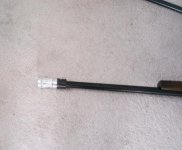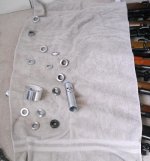See. There is where the specific moment of inertia of the tuner comes into play. At the top of the 1st order swing the muzzle is at the 1st order anti node - with the correct tuner mass this is also when the bullet exits. However this point is also the first 2nd order node - where angular velocity is at it's highest - and with a tuner with the correct Moment of Inertia this angular motion compensates for relatively small variations in muzzle velocity. Also I think I'm seeing that the sudden increase in barrel diameter of some of the reverse taper barrels might even mimic a condition, which could be mistaken for a "parallel node" - in that it is structurally removed from the propagated stress waveform - and results in a short straight bore section at the muzzle.
At the instant of the bullet leaving under these conditions there would be no yaw imparted to the bullet by a barrels transverse motion. the muzzle would be an instantaneous pivot point, being essentially stationary in the 1st order motion as well as the 2nd order, the short straight section would allow bullet stability to form while still in the choked area, and the escaping muzzle gasses would pass almost uniformly around all tangents to the bullet. Elimination of all of these sources of initial bullet yaw would have to help maintain a stable trajectory down range.
Vibe,
Your first and second mode model of barrel motion is an attractive one, and may be useful for conceptualizing how a tuner might work, but barrel (really, rifle) motion is more complicated.
First, assuming the first mode begins when the bullet enters the barrel, it would reach the top of its swing in a quarter cycle, about 3.1 milliseconds for the barrel without tuner that Al simulated. Even a rimfire bullet leaves sooner than that, about 2.6-2.7 milliseconds. Adding a tuner would make the first mode even slower.
Second, the whole natural frequency/mode shape description of vibration doesn't apply until the initial impulse creating the motion has propagated throughout the barrel, i.e., for times much longer than the product of the length of the barrel times the wavespeed. You can see this time in Al's simulations. For the fastest (longitudinal) wave, it takes about 0.7 milliseconds for the muzzle to move at all, even though large motions began earlier at the breech. Multiply this time by, say, 100 to estimate the time when periodic vibrations fully develop, about 70 milliseconds. By then, the bullet has been gone for at least 67 milliseconds. Like Al says, (paraphrasing here) the barrel is like a guitar string and the powder like a pick. The bullet leaves while the pick is still plucking the string. The steady state vibration happens later, much later.
A better simplified model of barrel motion might be that of a transverse traveling wave. You can see this in Al's simulations, too (for instance,
http://www.varmintal.com/a22lr.htm). The wave starting at the breech reaches the muzzle in about 1.5 milliseconds and raises the muzzle angle to a peak, then bounces back toward the breech. Timing bullet exit to the upslope before the second peak in muzzle angle at about 3 milliseconds would tune the rifle.
Cheers,
Keith



